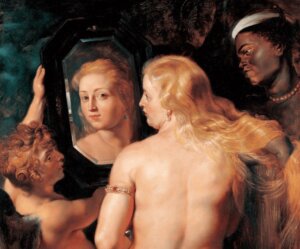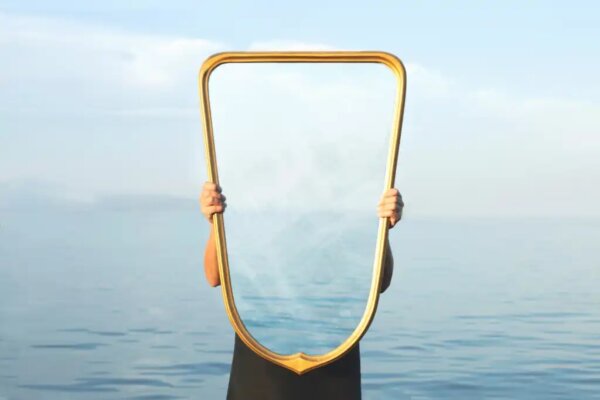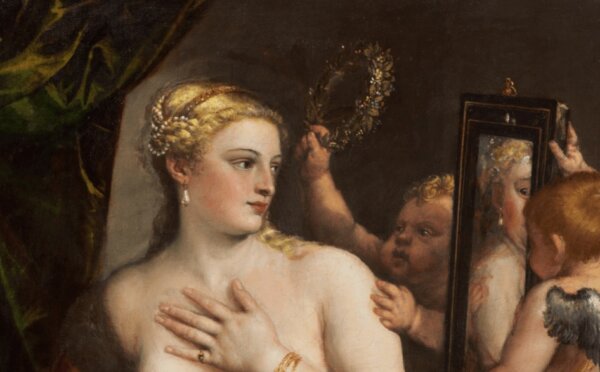The Venus Effect, a Fascinating Optical Illusion


Reviewed and approved by the psychologist Gema Sánchez Cuevas
Have you ever wondered why artists use mirrors in their paintings? It’s not by chance. Indeed, optical effects in works of art were and are a widely used resource utilized by artists. With them, they seek to stimulate your senses and make you linger for a while longer when looking at their paintings. One of these resources is called the Venus effect.
It’s a technical resource. However, it goes beyond the mere fact of creating an impression. It forms part of the psychology of perception. It concerns how artists manipulate an observer of their works, so they get the wrong impression about something.
This mistaken perception means that what you see reflected in a mirror isn’t what it looks like or what you expect to see.
“I know that mirrors give us a false sense of confidence.” I continued. “The reflection that we see every day has nothing to do with how others see us.”
-Rasmenia Massoud-
Overestimating what you see in the mirror

Mirrors themselves are extremely distinctive objects. They have an air of mystery. about them. Every day you see yourself and your surroundings reflected in them. It’s in that reflection where much of the enigma lies. Because not everything is as it seems. Indeed, humans have some erroneous beliefs about this simple and everyday object.
At the end of the day, our understanding of mirrors tends to be somewhat flawed. At least, that’s what a study published in the European Journal of Cognitive Psychology claims. It concerns our tendency to overestimate what we see in the mirror.
You anticipate your reflection in the mirror before it appears. For example, standing at a specific angle and not directly in front of a mirror, you’ll more than likely incorrectly anticipate when you’ll first start to see your reflection.
According to the study, this is known as early error. It means that, instead of taking perspective into account, you think that the mirror can only reflect the part of the room that equals the width of the mirror.
Several investigations have studied this effect. One of them is published in the National Library of Medicine (NLM). It claims that artists deliberately manipulate images to create the impression you get when you look in the mirror at yourself.
Some researchers have suggested that the heads of Venus depicted in the mirrors are too large in proportion to their faces. Furthermore, that Venus should be at least half the size of the mirror.
“We only see what we want to see; we only hear what we want to hear. Our belief system is just like a mirror that only shows us what we believe.”
-Don Miguel Ruiz-
Who’s Venus looking at?

The Venus effect involves a visual representation of a mirror. However, the mirror points towards the viewer of the painting instead of the subject of the artwork. This curious effect has been used by artists like Velázquez (Rokeby Venus), Titian (Venus with a Mirror), and Veronese (Venus with a Mirror).
Our understanding of the reflections in the mirrors of these paintings is flawed. The Venus effect refers to our self-centeredness in assuming that what the subject of a painting sees in the mirror is the same as we see.
The most common misperception is to imagine that the Venuses are looking at their reflections. The second is to imagine they’re looking at you. However, neither of these assumptions is correct. Because, in reality, they’re looking at the painter’s reflection.
Therefore, as the previous research we mentioned concluded, if the artists had painted these images as they saw them, the effects would’ve been less realistic. This surprising effect has also been used in film and television. It generates false perceptions and creates emotions. Finally, it makes you reflect on the extent to which, what you see in a painting and a mirror is true.
Have you ever wondered why artists use mirrors in their paintings? It’s not by chance. Indeed, optical effects in works of art were and are a widely used resource utilized by artists. With them, they seek to stimulate your senses and make you linger for a while longer when looking at their paintings. One of these resources is called the Venus effect.
It’s a technical resource. However, it goes beyond the mere fact of creating an impression. It forms part of the psychology of perception. It concerns how artists manipulate an observer of their works, so they get the wrong impression about something.
This mistaken perception means that what you see reflected in a mirror isn’t what it looks like or what you expect to see.
“I know that mirrors give us a false sense of confidence.” I continued. “The reflection that we see every day has nothing to do with how others see us.”
-Rasmenia Massoud-
Overestimating what you see in the mirror

Mirrors themselves are extremely distinctive objects. They have an air of mystery. about them. Every day you see yourself and your surroundings reflected in them. It’s in that reflection where much of the enigma lies. Because not everything is as it seems. Indeed, humans have some erroneous beliefs about this simple and everyday object.
At the end of the day, our understanding of mirrors tends to be somewhat flawed. At least, that’s what a study published in the European Journal of Cognitive Psychology claims. It concerns our tendency to overestimate what we see in the mirror.
You anticipate your reflection in the mirror before it appears. For example, standing at a specific angle and not directly in front of a mirror, you’ll more than likely incorrectly anticipate when you’ll first start to see your reflection.
According to the study, this is known as early error. It means that, instead of taking perspective into account, you think that the mirror can only reflect the part of the room that equals the width of the mirror.
Several investigations have studied this effect. One of them is published in the National Library of Medicine (NLM). It claims that artists deliberately manipulate images to create the impression you get when you look in the mirror at yourself.
Some researchers have suggested that the heads of Venus depicted in the mirrors are too large in proportion to their faces. Furthermore, that Venus should be at least half the size of the mirror.
“We only see what we want to see; we only hear what we want to hear. Our belief system is just like a mirror that only shows us what we believe.”
-Don Miguel Ruiz-
Who’s Venus looking at?

The Venus effect involves a visual representation of a mirror. However, the mirror points towards the viewer of the painting instead of the subject of the artwork. This curious effect has been used by artists like Velázquez (Rokeby Venus), Titian (Venus with a Mirror), and Veronese (Venus with a Mirror).
Our understanding of the reflections in the mirrors of these paintings is flawed. The Venus effect refers to our self-centeredness in assuming that what the subject of a painting sees in the mirror is the same as we see.
The most common misperception is to imagine that the Venuses are looking at their reflections. The second is to imagine they’re looking at you. However, neither of these assumptions is correct. Because, in reality, they’re looking at the painter’s reflection.
Therefore, as the previous research we mentioned concluded, if the artists had painted these images as they saw them, the effects would’ve been less realistic. This surprising effect has also been used in film and television. It generates false perceptions and creates emotions. Finally, it makes you reflect on the extent to which, what you see in a painting and a mirror is true.
All cited sources were thoroughly reviewed by our team to ensure their quality, reliability, currency, and validity. The bibliography of this article was considered reliable and of academic or scientific accuracy.
Bertamini M, Latto R, Spooner A. The Venus effect: people’s understanding of mirror reflections in paintings. Perception. 2003;32(5):593-9. doi: 10.1068/p3418. PMID: 12854645.
Marco Bertamini, Lauren A. Wynne (Nov 2009): The tendency to overestimate what is visible in a planar mirror amongst adults and children
This text is provided for informational purposes only and does not replace consultation with a professional. If in doubt, consult your specialist.







